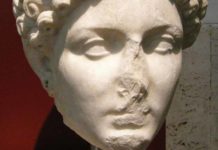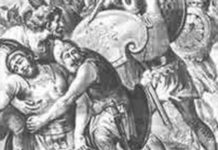People who had not been actively civilised by the Romans themselves or the Greeks before them were viewed by the Romans as barbarian. The Punic people of Africa, whose culture reflects Phoenician and Greek influences through ancestral and trading links, were regarded as barbarians nonetheless. Greek and Roman control were considered the only legitimate forces whereby people could become “de-barbarianised” because the Romans respected classical Greece as the foundation for Rome’s own, greater, achievements. The Roman poet Horace ironically observes: “Captive Greece took her rough conqueror captive”. Pliny confirms this view in a letter to his friend Valerius (?) Maximus in which he suggests that Valerius should remember, before taking up an official post in Achaea, that in Greece “civilization and literature, and agriculture, too, are believed to have originated”.
Pliny hopes his young friend will not abuse his powerful position in Greece because this “would be an act of cruelty, ignorance and barbarism.” Pliny regards the prospect of such bad behaviour particularly shameful because not only should civilized Romans know better, but the Greeks would think they were behaving like barbarians. Pliny’s remark might be interpreted to mean he thinks barbarism is the sum of cruelty and ignorance rather than a third, separate, trait. In either case, it is a pejorative term and suggests that barbarism is equated with cruelty and ignorance and is the opposite of civilization. In the context of this letter, therefore, civilization should bring with it kindness and respect and these are qualities Pliny expects Romans to exhibit towards a people with whom Rome had a special relationship.
Barbarian Europe – uncivilized society
Others, however, who had no such relationship with Rome, were treated differently. The carvings on the column of Marcus Aurelius in Rome shows direct conflict between the civilized and the uncivilized, with Roman soldiers asserting their superiority on the battlefield and among the civilian population of what is now Eastern Europe. Particular emphasis has been placed on the facial expressions of the civilians, showing their fear and misery; and it is hard for us from our modern cultural standpoint to appreciate the response scenes like this were meant to elicit. The simplest interpretation is that the powerful are shown overcoming the weak, but of course pitting trained soldiers against defenceless people is no contest. Therefore it is more likely that its purpose was to show that territorial gain was of paramount importance over any amount of suffering on the part of the natives.
The Romans regarded it their divinely ordained duty not so much to destroy as many barbarians as possible but rather to make them part of the empire, thus fulfilling the prophecy in Virgil’s Aeneid that “great Rome shall rule to the ends of the earth.” Also, the burning of the round, wooden houses in this European scene is important because it would have shown the Roman viewer both the strangeness of the barbarians’ houses and the Roman army’s response to them; thereby giving the image a deeper significance than merely illustrating people being forced out of their homes. Romans would have rationalised this action because, according to Virgil, Rome was founded by Aeneas, son of the goddess Venus. This gave divine justification to Rome’s existence and, through the prophecies expressed in the Aeneid, to its empire.








